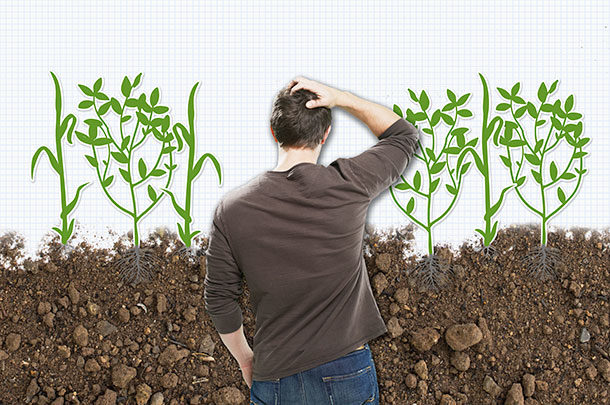Matt and I own Mills Mid-Iowa Machinery and a farm about 5 miles north of Pella. We decided to try planting corn with soybeans to chop and make silage for cattle feed. The idea came from an article published in Progressive Forage magazine. The article featured a farmer located in Montana, Greg Schlemmer. Schlemmer has been doing this for years.
Matt contacted Schlemmer and had multiple conversations about where, why and how this corn-and-soybean crop was produced. The goal in growing soybeans side by side with corn is to increase the productivity of each acre. Increasing the plant population and adding a second plant variety would increase the feed tonnage produced and improve the feed quality – a cattle producer’s ideal goal for producing silage.
This all sounds great, but if it was easy, shouldn’t everybody be doing it? Why aren’t they? After more conversations with other farmers, seed specialists and agronomists, there were a lot of opinions. Most said, “It just won’t work.” A lot of concerns included selecting seed varieties, water needs, fertilizer requirements and weed control.
Choosing the most compatible corn and soybean varieties seemed to be the biggest challenge. You need a soybean plant that can grow fast enough to keep up with the corn. If the corn foliage canopy closes over the bean plants, there will not be enough sunlight to sustain the bean plant. A tall corn plant provides more foliage to ensile (producing more feed), but it can’t overpower the bean plant.
The soybean plant also needs to grow tall to get the sunlight it needs. The plants also need to get to the proper stage of maturity at the same time since they are planted on the same day. The best silage requires a corn plant that has fully mature ears of corn, but the soybean plant should not be allowed to get to full maturity.
At the time of chopping, it is ideal for the bean plant to be immature. If the plant is allowed to set beans in the pod, then the plant proteins have been pulled away from the foliage and reduces the quality of the plant for cattle consumption. Harvesting mature corn and almost-mature soybeans will produce the most nutrient-rich silage.
Moisture is also a concern. Will the densely planted field have enough water with average rainfall? Schlemmer said the bean foliage creates an evaporation barrier close to the soil and greatly reduces the amount of moisture that evaporates off the soil. Therefore, average rainfall is adequate for the double crop. He also said weeds were quickly choked out by the high density of plants and had not been a problem.
So after much conversation and debate, we planted a small field. An old eight-row White planter was set up. Half the planter boxes (on the right side of the planter) were set for corn, and the other side of the planter was set up for the soybeans. The corn was planted at a population of 32,000 plants per acre, and the soybeans were planted at a population of 132,000 plants per acre on 30-inch rows. After planting one pass, we turned around and made another pass, planting in between the rows of the first pass. This gave us alternating rows of corn and soybeans 15 inches apart. We decided, if possible, we’d plant the rows east to west to get the maximum sunlight and reduce shading.
Darren Boot with VanKo Chopping chopped the field at harvest when the corn-soybean combo was ready. The soybeans added an extra dimension to chopping and needed an operator with more skill than the average operator.
The tonnage for the field was about 1 1/4 times what would be expected with corn only. After letting the silage ferment for about 60 days, the silage was tested by Two Rivers Co-op to evaluate the nutritional values. The digestible protein was more than double for the corn-soybean mix over the corn-only silage.
So, was it successful? Yes, and we will certainly plant the double crop again next year. Maybe crazy neighbors aren’t as crazy after all. ![]()
Author note: Special thanks to Dave Boot for planting the field for us, to Prairie Creek Seeds for supplying the seed at a very cost-effective price point, and to Darren Boot for providing excellent chopping technique. We will be drawing on their expertise in the future.
Luane Mills is co-owner of Mid-Iowa Machinery. Email Luane Mills.
PHOTO: Illustration by Corey Lewis.










